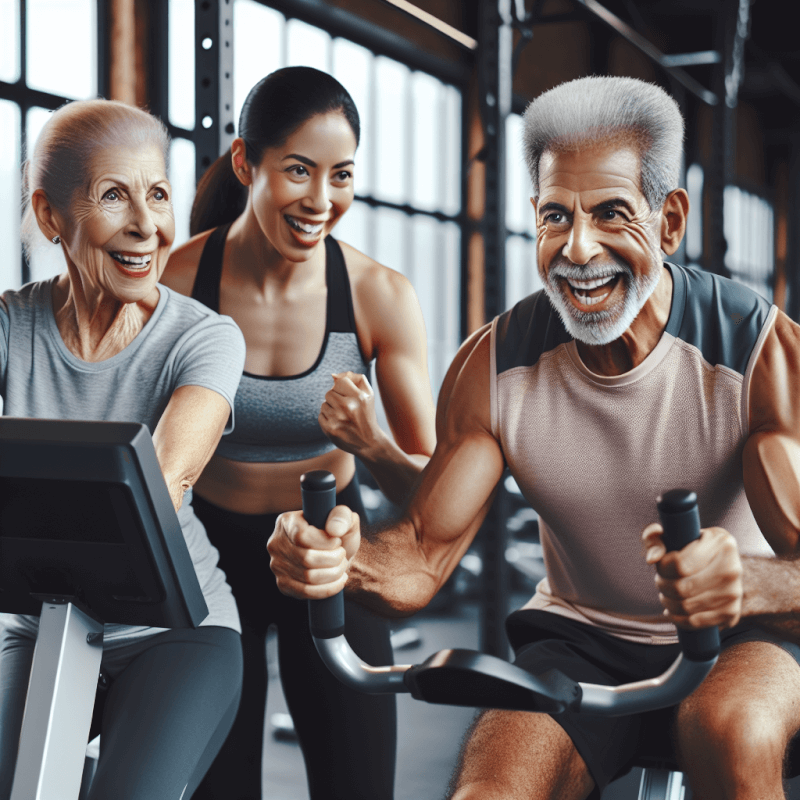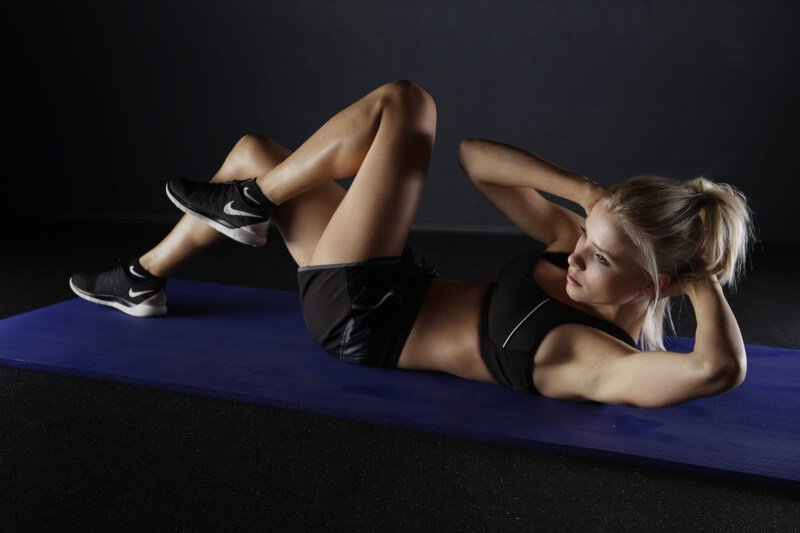Are you over 50 and looking to kick your fitness routine up a notch? Look no further! This article is packed with valuable information on intense workouts specifically designed for individuals in their 50s and beyond. Discover the best exercises and training techniques to challenge your body, improve your strength and flexibility, and defy the limitations of age. Get ready to feel stronger, fitter, and more energized than ever before as we guide you through these intense workouts tailored to your needs and goals.
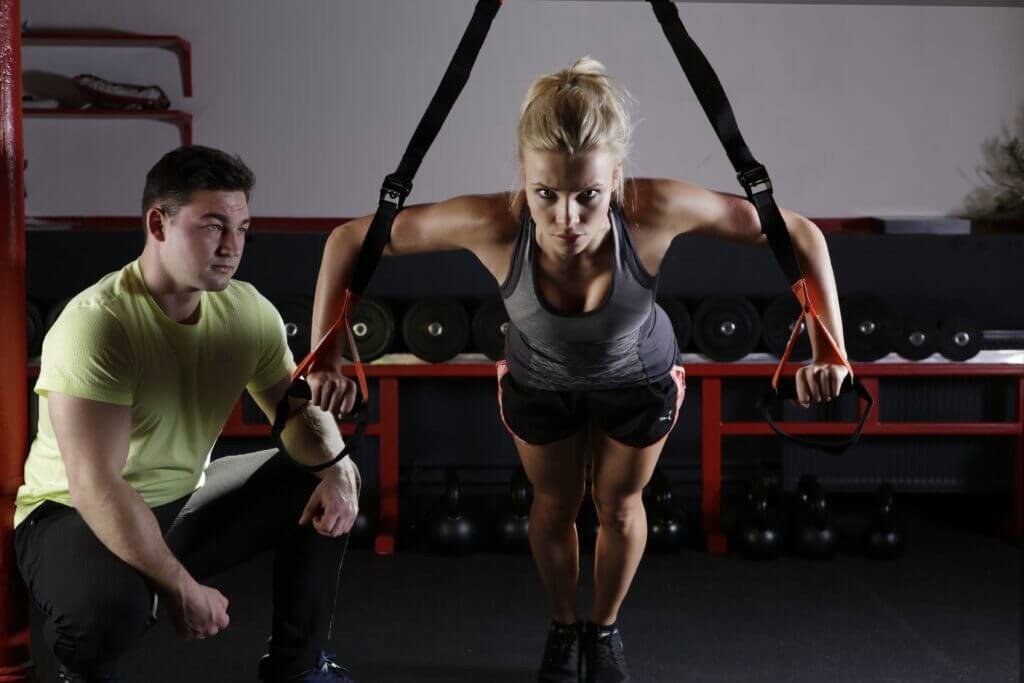
Benefits of Intense Workouts for Over 50
As you age, incorporating intense workouts into your fitness routine can have numerous benefits for your overall health and well-being. Here are some key advantages of intense workouts for individuals over 50:
Increased Strength and Muscle Mass
Intense workouts, particularly strength training exercises, can help increase your muscle strength and mass. As we age, we naturally experience muscle loss, known as sarcopenia. However, by engaging in regular intense workouts, you can slow down this process and even reverse it to some extent. Building lean muscle mass not only improves your physical appearance but also enhances your functional abilities and overall strength.
Improved Bone Density
Another significant benefit of intense workouts for individuals over 50 is the improvement in bone density. Intense exercises, such as weightlifting and high-impact activities like running or jogging, can stimulate the production of new bone tissue and help prevent conditions like osteoporosis. By challenging your bones through intense workouts, you can increase their density and reduce the risk of fractures and other bone-related issues.
Enhanced Cardiovascular Health
Engaging in intense cardiovascular workouts can greatly improve your cardiovascular health. Intense exercises, such as high-intensity interval training (HIIT), cycling, running, rowing, and jumping rope, can elevate your heart rate and strengthen your heart muscles. Regular intense cardio workouts help improve blood circulation, lower blood pressure, and reduce the risk of heart diseases. Incorporating these exercises into your routine can boost your stamina and overall cardiovascular fitness.
Weight Management and Fat Loss
Intense workouts are highly effective for weight management and fat loss. As we age, our metabolism naturally slows down, making it easier to gain weight and more difficult to shed excess pounds. However, by incorporating intense workouts into your routine, you can rev up your metabolism and burn more calories even at rest. Intense workouts also help build lean muscle mass, which further enhances your body’s ability to burn fat. Utilizing a combination of cardiovascular exercises and strength training, you can achieve and maintain a healthy weight.
Improved Cognitive Function
Intense workouts have been shown to have positive effects on cognitive function, memory, and brain health. Regular physical activity increases blood flow to the brain and promotes the release of chemicals that enhance mood and cognitive function. Intense workouts trigger the release of endorphins, which are natural mood-enhancing chemicals that can boost your overall mental well-being. Studies have also suggested that intense exercise may help reduce the risk of cognitive decline and certain neurological disorders, such as Alzheimer’s disease.
Reduced Risk of Chronic Disease
Engaging in intense workouts can significantly reduce the risk of chronic diseases that are prevalent among individuals over 50. Regular exercise has been associated with a lower risk of conditions such as heart disease, type 2 diabetes, certain types of cancer, and metabolic syndrome. Intense workouts help improve various markers of health, including blood pressure, cholesterol levels, and blood sugar control. By incorporating intense workouts into your routine, you can effectively reduce the likelihood of developing these chronic diseases and maintain a high quality of life.
Considerations Before Starting Intense Workouts
Before embarking on an intense workout regimen, there are a few important considerations to keep in mind to ensure your safety and maximize the benefits. Here are some key factors to consider:
Consulting with a Healthcare Professional
It is essential to consult with your healthcare professional before starting any intense workout program, especially if you have any pre-existing medical conditions or if you haven’t been physically active for an extended period. A healthcare professional can evaluate your overall health, assess any potential risks, and provide recommendations specific to your circumstances.
Assessing Fitness Level and Goals
Before starting intense workouts, it’s important to assess your current fitness level and set realistic goals. Understanding your current capabilities will help you tailor your workout plan to meet your specific needs and avoid potential injuries. Set both short-term and long-term goals to help monitor your progress and keep yourself motivated.
Choosing Suitable Workout Programs
There are various intense workout programs available, and it’s important to choose one that aligns with your fitness level, goals, and preferences. Whether you prefer strength training, cardio exercises, or a combination of both, selecting a program that suits your interests will make it more enjoyable and sustainable in the long run.
Warming Up and Cooling Down
Before engaging in any intense workout, make sure to incorporate a proper warm-up routine. Warming up allows your body to gradually increase its heart rate and prepare your muscles for the upcoming intense activity. Likewise, cooling down after your workout session with stretching exercises will help prevent muscle soreness and promote flexibility.
Monitoring Exercise Intensity
When starting intense workouts, it’s important to listen to your body and gradually increase the intensity of your workouts over time. Pushing yourself too hard too soon can lead to injuries and setbacks. Aim to challenge yourself while maintaining proper form and technique, and monitor your heart rate and breathing rate to ensure you’re working within your target intensity zone.
Cardiovascular Intense Workouts
Cardiovascular intense workouts are an excellent way to improve your endurance, burn calories, and boost your cardiovascular health. Here are some popular intense cardiovascular exercises for individuals over 50:
High-Intensity Interval Training (HIIT)
HIIT involves short bursts of intense exercise followed by short rest periods. This workout method not only improves cardiovascular fitness but also helps burn calories efficiently in a shorter amount of time. Some common HIIT exercises for individuals over 50 include jump squats, mountain climbers, high knees, and burpees.
Cycling
Cycling is a low-impact cardiovascular exercise that can be done indoors on a stationary bike or outdoors on a bike. It provides a great cardiovascular workout while minimizing stress on the joints. Cycling can be easily modified to suit different fitness levels, and it allows you to control the intensity based on your preferences.
Running or Jogging
Running or jogging is an effective way to improve cardiovascular fitness and endurance. It can be done anywhere and doesn’t require any special equipment. If you’re new to running or jogging, start gradually and increase your intensity and duration over time. Consider alternating between running and walking to prevent overexertion.
Rowing
Rowing is a full-body workout that engages multiple muscle groups and provides a challenging cardiovascular workout. It can be done on a rowing machine or in a boat if you have access to a body of water. Rowing is a low-impact exercise that puts minimal stress on the joints while providing a high-intensity workout.
Jumping Rope
Jumping rope is a fun and effective cardiovascular exercise that can be done virtually anywhere with minimal equipment. It is a high-impact workout that helps improve coordination, agility, and cardiovascular endurance. Start with shorter intervals and gradually increase your jumping time as your fitness level improves.
Strength Training Intense Workouts
Strength training is crucial for individuals over 50 as it helps maintain muscle mass, improve bone density, and increase overall strength. Here are some intense strength training exercises suitable for individuals over 50:
Compound Exercises
Compound exercises involve multiple muscle groups and joints, making them effective for building strength and muscle mass. Examples of compound exercises include squats, lunges, deadlifts, bench presses, and shoulder presses. Incorporating these exercises into your routine can help target multiple muscle groups simultaneously and increase overall strength.
Weightlifting
Weightlifting is a popular form of strength training that involves using free weights or weight machines to increase resistance. It helps build muscle strength, improve bone density, and enhance overall functional abilities. When starting weightlifting, it is crucial to start with lighter weights and focus on proper form and technique. Gradually increase the weight as your strength and confidence improve.
Bodyweight Exercises
Bodyweight exercises are an excellent option for intense strength training without the need for any equipment. Exercises like push-ups, pull-ups, squats, and planks can effectively target various muscle groups and provide a challenging workout. Bodyweight exercises can be modified to suit different fitness levels and can be done anywhere, making them convenient and accessible.
Resistance Band Training
Resistance band training is a low-impact but highly effective form of strength training. Resistance bands provide variable resistance, challenging your muscles throughout the entire range of motion. They are portable, affordable, and can be used to target different muscle groups. Resistance band exercises are ideal for individuals over 50 as they provide joint-friendly resistance and can easily be adapted to different fitness levels.
Functional Training
Functional training focuses on exercises that mimic everyday movements, improving your overall functional abilities. It involves using multiple muscle groups simultaneously to enhance strength, stability, and flexibility. Examples of functional training exercises include squats, lunges, planks, and medicine ball throws. Incorporating functional training into your routine can improve your ability to perform activities of daily living and reduce the risk of injury.
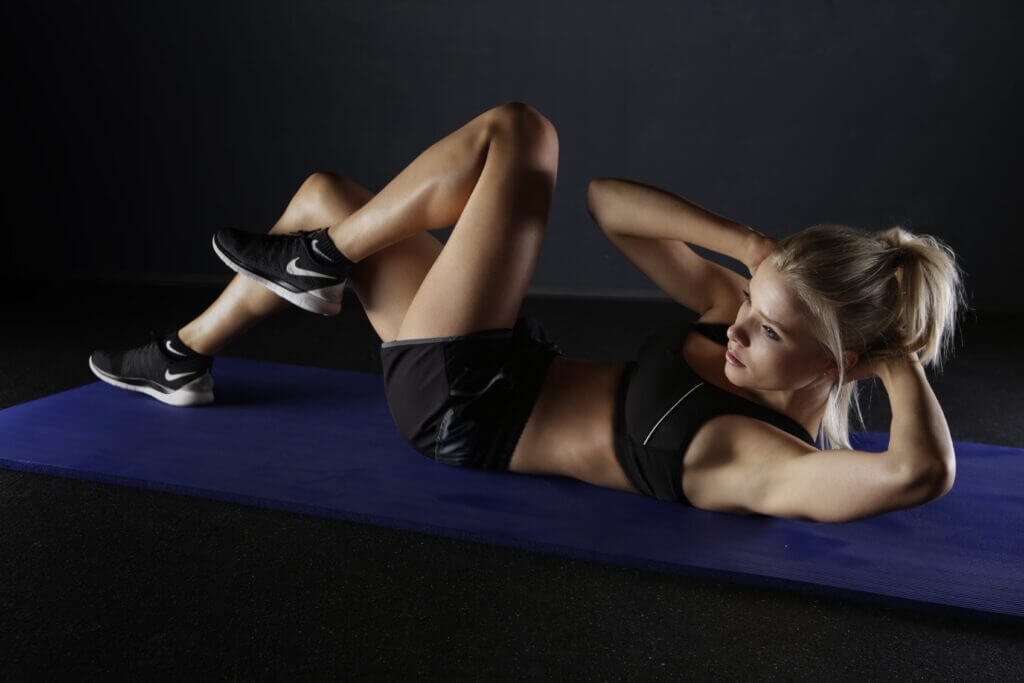
Flexibility and Mobility Intense Workouts
Flexibility and mobility workouts are essential for individuals over 50 as they help maintain joint range of motion, prevent injuries, and improve overall movement quality. Here are some intense flexibility and mobility workouts to consider:
Yoga
Yoga is a popular form of exercise that combines stretching, strength, and balance training. It promotes flexibility, improves posture, and enhances overall body awareness. Yoga classes designed for individuals over 50 often focus on gentle poses and modifications to accommodate different fitness levels and limitations. Regular yoga practice can help improve flexibility and mobility while promoting relaxation and stress reduction.
Pilates
Pilates is a low-impact exercise method that focuses on core strength, flexibility, and overall body control. It emphasizes precise movements and proper alignment to enhance body awareness and improve posture. Pilates exercises can be modified to suit different fitness levels, making it suitable for individuals over 50. Regular pilates practice can help improve core strength, flexibility, and overall body coordination.
Tai Chi
Tai Chi is a traditional Chinese martial art that combines slow, flowing movements and deep breathing. It is known for its numerous health benefits, including improved balance, flexibility, and stress reduction. Tai Chi exercises are low-impact and can be modified to accommodate different fitness levels. Regular practice of Tai Chi can help improve flexibility, coordination, and overall body awareness.
Stretching and Foam Rolling
Incorporating stretching exercises into your routine is essential for maintaining flexibility and preventing muscle tightness. Stretching exercises can be done before and after intense workouts to warm up and cool down your muscles. Additionally, using a foam roller is a great way to release muscle tension and improve mobility. Foam rolling helps break up adhesions in the muscles and fascia, enhancing flexibility and reducing the risk of injury.
Dynamic Mobility Exercises
Dynamic mobility exercises involve moving your joints through a full range of motion in a controlled manner. These exercises help improve joint mobility, increase blood flow, and warm up the muscles. Examples of dynamic mobility exercises include arm circles, leg swings, hip rotations, and shoulder rolls. Incorporating dynamic mobility exercises into your warm-up routine can help prepare your body for intense workouts and improve overall mobility.
Nutrition for Intense Workouts
Proper nutrition plays a crucial role in supporting your intense workouts and maximizing their benefits. Here are some key nutrition considerations for individuals over 50 engaging in intense workouts:
Balanced Diet with Adequate Protein
Maintaining a balanced diet is crucial to support your intense workouts. Focus on consuming a variety of nutrient-dense foods, including lean proteins, whole grains, fruits, vegetables, and healthy fats. Adequate protein intake is particularly important for muscle repair and recovery. Include lean sources of protein, such as chicken, fish, tofu, Greek yogurt, and eggs, in your meals to ensure you’re meeting your protein needs.
Proper Hydration
Staying hydrated is essential for optimal performance and recovery. Make sure to drink enough water before, during, and after your intense workouts. The exact amount of water you need can vary depending on factors like your body size, activity level, and environmental conditions. However, a general guideline is to aim for at least 8 glasses (64 ounces) of water per day. If you’re engaging in intense workouts or exercising in hot weather, you may need to increase your fluid intake accordingly.
Pre- and Post-Workout Nutrition
Eating the right foods before and after your intense workouts can fuel your body and aid in recovery. Prior to your workout, consume a balanced meal or snack that includes carbohydrates for energy and a small amount of protein for muscle repair. Consider options like a banana with peanut butter, Greek yogurt with berries, or a whole grain wrap with lean protein. After your workout, focus on replenishing glycogen stores and promoting muscle recovery by consuming a combination of protein and carbohydrates. A post-workout shake with protein powder and a piece of fruit or a balanced meal with lean protein and whole grains can be beneficial.
Supplementation
Supplements can be useful for individuals engaging in intense workouts, but they should not replace a balanced diet. Consult with your healthcare professional or a registered dietitian before starting any new supplements to ensure they are safe and suitable for your individual needs. Common supplements used by individuals over 50 engaging in intense workouts include protein powders, fish oil, and multivitamins.
Avoiding Overeating or Undereating
Properly fueling your body is crucial for optimal performance during intense workouts. Avoid overeating before your workouts, as this can cause discomfort and may hinder your ability to exercise effectively. Likewise, make sure you’re consuming enough calories to support your activity level and meet your nutritional needs. Undereating can lead to insufficient energy levels and may impede your progress. Listen to your body’s hunger and fullness cues and aim for a balanced approach to fueling your workouts.

Recovery and Rest
While intense workouts can yield numerous benefits, it’s important not to overlook the importance of recovery and rest. Here are some key considerations for optimizing your recovery:
Importance of Rest Days
Incorporating rest days into your workout routine is crucial for allowing your body to recover and adapt to the physical stress of intense workouts. Rest days help prevent overtraining, reduce the risk of injuries, and promote overall muscle and tissue repair. Aim to have at least one or two rest days per week, where you engage in lighter activities or focus on stretching and mobility work.
Incorporating Active Recovery
Active recovery involves engaging in low-intensity activities that promote blood flow and help reduce muscle soreness. This can include activities like gentle yoga, swimming, walking, or cycling at a leisurely pace. Active recovery helps enhance circulation, reduce inflammation, and facilitate muscle recovery. Incorporating active recovery into your routine on your rest days can help promote overall recovery and prevent stiffness and soreness.
Getting Sufficient Sleep
Getting adequate sleep is crucial for your overall health and recovery from intense workouts. During sleep, your body repairs and regenerates tissues, releases growth hormones, and consolidates learning and memory. Aim for 7-9 hours of quality sleep each night to support your body’s recovery processes. Establish a consistent bedtime routine and create an environment that promotes relaxation and good sleep hygiene.
Managing Stress Levels
Managing stress levels is important for your overall well-being and recovery. Intense workouts can be physically demanding, and it’s important to balance your exercise regimen with stress-management techniques. Incorporate activities like meditation, deep breathing exercises, or engaging in hobbies you enjoy to help manage stress. Chronic stress can hinder your recovery and progress, so making time for relaxation and self-care is crucial.
Listening to Your Body
Above all, listen to your body and adjust your workout routine and intensity as needed. If you’re feeling excessively fatigued or experiencing pain or discomfort, it’s important to take a step back and allow yourself adequate rest and recovery. Pushing through intense workouts when your body is signaling for rest can lead to injuries and setbacks. Pay attention to how your body feels and make adjustments accordingly to ensure long-term sustainability and optimal results.
Common Injuries and Prevention
Engaging in intense workouts, especially as an individual over 50, can pose certain risks for injuries. It’s important to be aware of these risks and take necessary precautions to prevent injuries. Here are some key considerations for injury prevention:
Understanding Age-Related Risks
As we age, our bodies may be more prone to certain injuries due to factors like decreased muscle mass, joint stiffness, and reduced flexibility. Understanding these age-related risks can help you tailor your workout routine and be mindful of potential vulnerabilities. Adjust your exercises and techniques to accommodate any limitations or pre-existing conditions you may have.
Proper Technique and Form
Using proper technique and maintaining proper form during your workouts is essential for preventing injuries. Improper form and technique can place unnecessary stress on your joints and muscles, increasing the risk of strains, sprains, and other injuries. Seek guidance from a qualified fitness professional or trainer when starting a new exercise or strength training program to ensure you’re using correct form.
Gradual Progression
Gradually progressing in your workouts is key to avoiding overuse injuries and allowing your body to adapt to increased demands. Avoid pushing yourself too hard or too fast, especially when starting a new intense workout regimen. Gradually increase the intensity, duration, or resistance of your exercises over time to allow your body to adapt and reduce the risk of overexertion.
Using Protective Gear
Using appropriate protective gear is crucial when engaging in intense workouts to minimize the risk of injuries. Depending on the type of workout you’re doing, consider using gear such as helmets, knee pads, wrist supports, or appropriate footwear. Protective gear can provide additional support and cushioning for your joints and reduce the risk of impact-related injuries.
Physical Therapy and Rehabilitation
If you’re recovering from an injury or have pre-existing conditions, consulting with a physical therapist or rehabilitation specialist can be beneficial. They can guide you in developing a safe and effective exercise program that takes into account your specific needs and limitations. Physical therapy can help strengthen weak muscles, improve joint mobility, and reduce pain or discomfort, allowing you to engage in intense workouts safely.
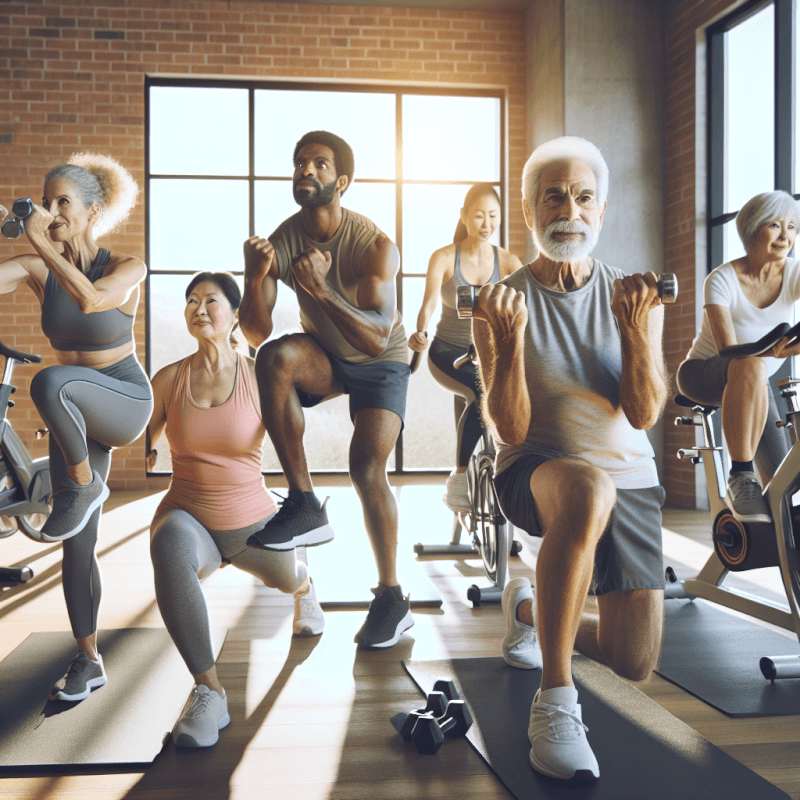
Exercise Modifications and Adaptations
It’s important to adapt your intense workouts to accommodate any pre-existing conditions or limitations you may have. Here are some considerations for making exercise modifications:
Accounting for Pre-existing Conditions
If you have pre-existing medical conditions or physical limitations, it’s crucial to make exercise modifications that suit your needs. For example, if you have knee issues, opting for low-impact exercises like swimming or cycling may be more appropriate. Consult with your healthcare professional or a qualified fitness professional to help you identify suitable exercise modifications.
Low-Impact Options
Low-impact exercises are gentler on the joints and can be a great option for individuals over 50 who may have joint stiffness or arthritis. Examples of low-impact exercises include swimming, cycling, elliptical training, and water aerobics. These exercises provide cardiovascular benefits without placing excessive stress on the joints, reducing the risk of injury.
Alternative Equipment
Using alternative equipment can help make certain exercises more accessible and reduce the risk of strain or injury. For example, individuals with wrist issues can opt for push-up bars to reduce the strain on the wrists. Resistance bands and suspension trainers can also provide a lower joint impact compared to free weights or weight machines, making them suitable alternatives for individuals with joint issues.
Appropriate Intensity Levels
Adjusting the intensity levels of your workouts is crucial for individuals over 50 to prevent overexertion and reduce the risk of injury. Listen to your body and modify the intensity to suit your current fitness level and capabilities. Focus on performing exercises with proper form and gradually increase the intensity as your strength and endurance improve.
Tracking and Adjusting
Tracking your workouts and progress is beneficial for monitoring your fitness level and making necessary adjustments. Keep a workout journal or use a fitness tracking app to record your exercises, sets, repetitions, and any modifications or adaptations you make. This will help you identify patterns, track your progress, and make informed decisions about adjusting your workouts as needed.
Motivation and Support
Maintaining motivation and finding support are important factors in sustaining an intense workout regimen. Here are some strategies to stay motivated and find the support you need:
Setting Realistic Goals
Setting realistic and achievable goals is crucial for maintaining motivation. Break down your long-term goals into smaller, more manageable milestones that you can track and celebrate along the way. Having a clear sense of direction and purpose will help keep you motivated and focused on your fitness journey.
Creating a Workout Routine
Establishing a consistent workout routine can help you stay on track and make your intense workouts a regular part of your life. Set aside dedicated time for exercise in your schedule and treat it as a non-negotiable appointment with yourself. Incorporate variety into your routine to keep things interesting and prevent boredom.
Finding Workout Partners or Classes
Finding a workout partner or joining group fitness classes can provide motivation, accountability, and a sense of community. Working out with a friend or participating in group classes can make your workouts more enjoyable and provide an extra level of support. Look for fitness classes or social groups specifically designed for individuals over 50 to connect with like-minded individuals and stay motivated together.
Joining Supportive Communities
Online communities and social media groups focused on fitness for individuals over 50 can provide a valuable source of support and inspiration. Joining these communities allows you to connect with others who share similar goals and challenges, providing a platform for sharing experiences, tips, and encouragement. Engaging with supportive communities can help you stay motivated and celebrate your milestones and progress.
Celebrating Milestones and Progress
Don’t forget to celebrate your accomplishments and milestones along your fitness journey. Recognize and reward yourself when you reach specific goals or overcome challenges. Celebrating your progress will help reinforce positive behaviors and motivate you to continue pushing forward.
Incorporating intense workouts into your routine as an individual over 50 can have numerous benefits for your physical and mental well-being. By considering the necessary precautions, choosing suitable workout programs, and focusing on nutrition, recovery, and injury prevention, you can safely and effectively engage in intense workouts and achieve optimal results. Remember to listen to your body, stay motivated, and seek support when needed. Embrace the journey and enjoy the many rewards that intense workouts can bring to your life.
